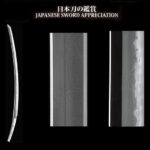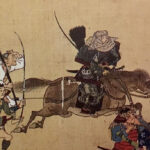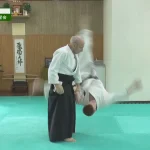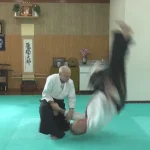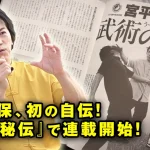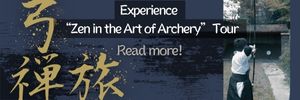THE 19TH KENDO WORLD CHAMPIONSHIP IN MILANO
Text by Claudio Regoli

After an interval of 6 years, due to pandemics, the 19th Kendo world Championships took place from 4 to 7th of July in Milano.
After some research, the Unipol forum of Assago, just on the outside line of Milano was chosen, also for his immediate facilities of hotels that could take care of the many contenders and officials.
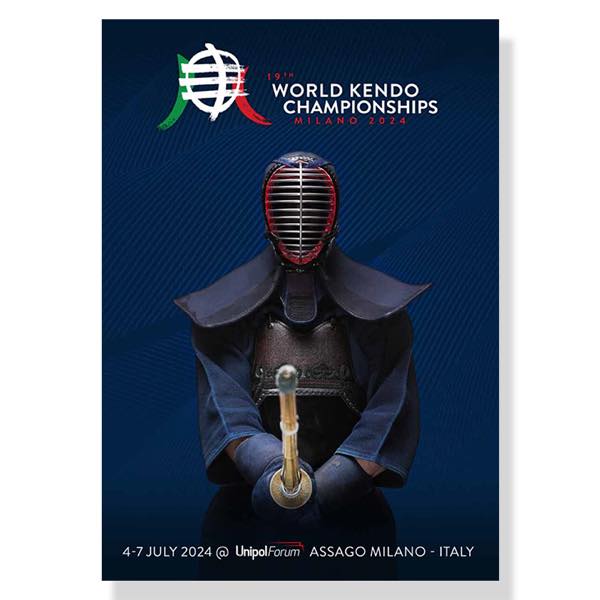
The organizing commitee worked very hard this last year to tend to all the menials that are one of the secrets of a smooth event: the shiaijo flooring, the meals for the contenders, the transports, the sponsors,and, first of all: the vounteers that helped the organization and the athletes. there were 140 of them, all kendo players, many of them high grades, nearly all speaking two or more languages, all of them helpful, kind and patient, mantaining order without being too harsh, and helping the athletes and the officials in their various needs.
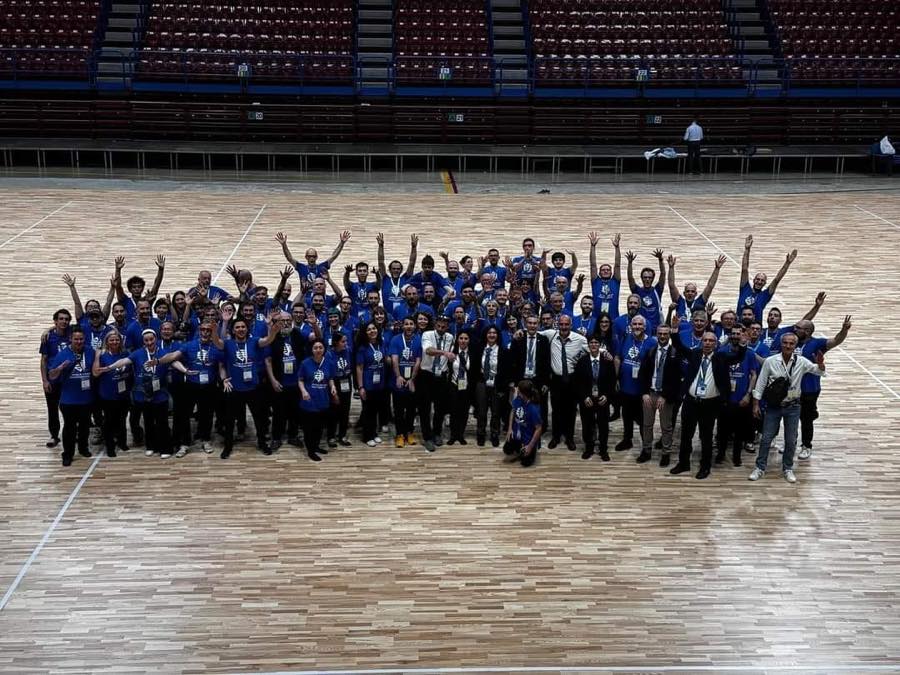
the vounteers and staff
This edition there were 62 national teams, of the around 90 nations affiliated or under probation of the International Federation.
Africa competed with just two teams:Tunisia and South Africa, whilst Asia had a limited number of nations taking part, also considering that China was present with three teams (People’s Republic of China, Macao and Hong Kong) due to historical past, like Hawaii, part of the USA, has also a team of their own.The new entries of these Championship were Ucraine and Uruguay.
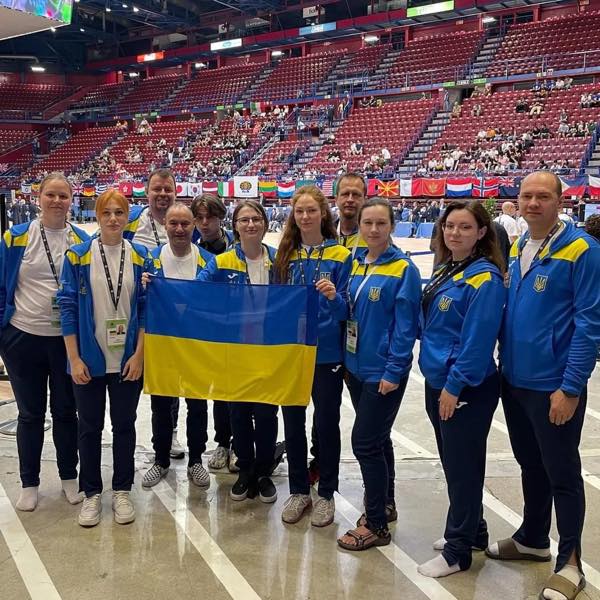
the Ucraine team
As a general comment, we can notice a predominance, also in other national teams, of competitors of Japanese or Korean origin. The gap between these two nations and the rest of the world is diminishing but it is still existing, and these persons, born in the state but of Japanese or Korean origin are helping the various nations to diminish this gap.
Among the many referees designated for the event,there were eight ladies, that performed greatly, at the level of their males counterparts.
Now: Kendo is a big unified effort to help friendship among the players through a dedicated work to improve the persons with the serious study of Japanese Swordsmanship. During these years, the effort made was very big, and it has been very appreciated by everyone that Korea had adequated their uniform to the one that everybody else is using.
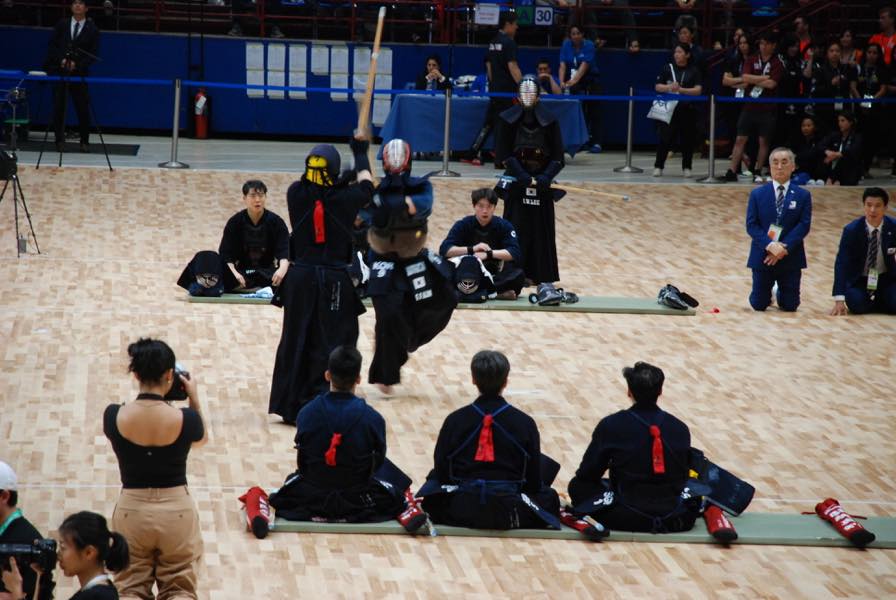
The Korean team
However, in these years, a difference has emerged between what we could call “classic Kendo” (like the one that is required to pass the grading exams) and “competition Kendo” with some ugly but effective mannerisms. However, we must notice that in the final fights a better quality of Kendo was played with good mahai and right distances that led to magnific actions.
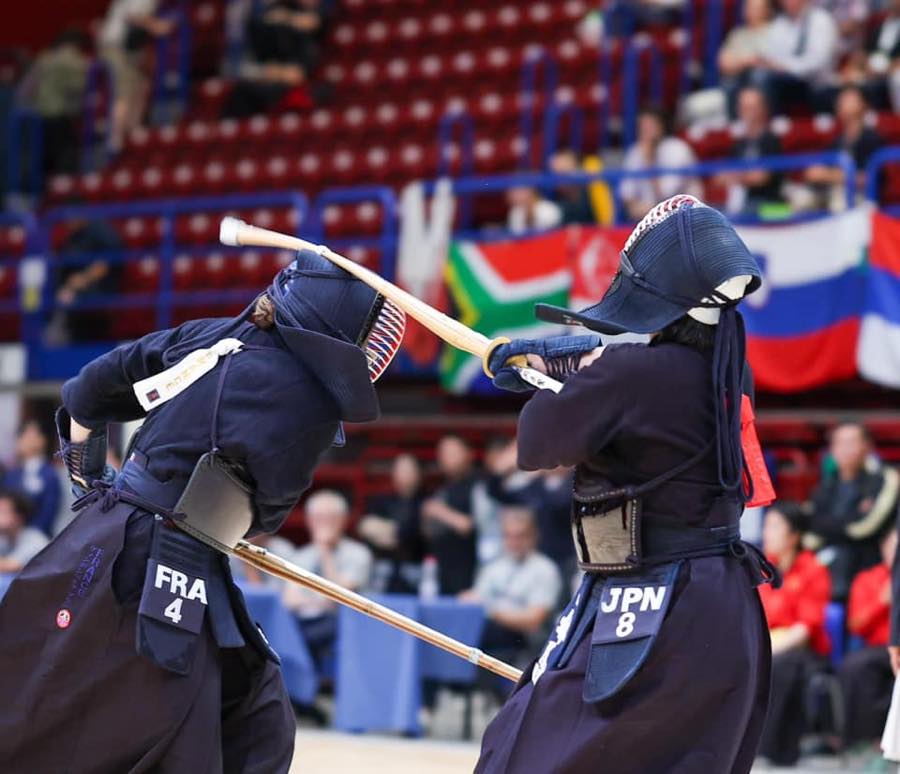
Senoo against Vandenberghe
Day1(JULY 4 – THURSDAY): WOMEN’S INDIVIDUAL CHAMPIONSHIP
The event started on the fourth with the ladies individual competitions, with 203 competitors. After the opening ceremony, with all the nations following their own flag and filling up the great shiaijo, and the introductory speaches,the round robins started.
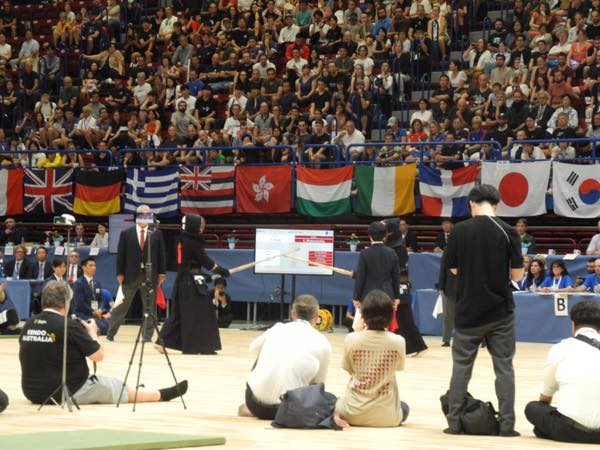
There were six shiai jo, allowing six contemporary matches.During the round robin we assisted to the match between China 1 Liao against Chinese Taipei Wu, with the last winning for 2 to 1.and emerging from the RR to be beaten in the first eliminatory by the canadian Park.
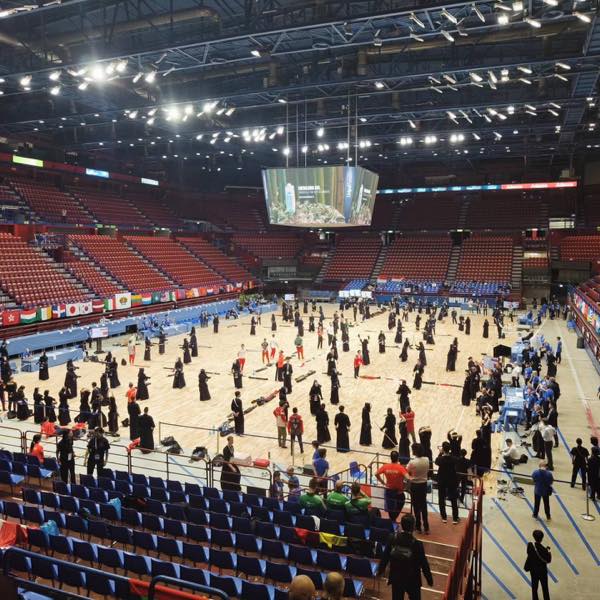
From the round robins emerged 64 competitors, soon reduced to 32. At this point already you could see which nations had the best competitors, in fact, in the group that passed to 32 there were 4 Japanese 3 English, 3 Canadians 2 Brazilians, 3 Koreans, 4 French, with other nations represented by just one.
The following round saw two French ladies: Guadarrama and Vandenberghe eliminate a Korean and a Japanese-Brazilian.
The following step started to show who were the strongest, there were only 8 left; Saito won on the Canadian Paik and the Australian Kushikawa won on the really strong French Guadarrama, Japan 3 Kondo won on Can 1 Park, Japan 2 Suenaga dispatched the last British Fisher ( her surname, Miyabi, giving an hint of her great capability) and Senoo beated the USA Tada. Then , there were just the four Japanese athletes to fight in the semifinals, that led to the final between Kondo and Suenaga, a splendid and quite clean fight that saw both competitors move like dragonflies, menacing the opponent and countering her seme, in a great display of grace and technique. Suenaga scored first with a kote, to which Kondo replied by another kote. The match came to encho, and on the second encho Kondo hit with a do that was not given, but the following encho saw Kondo Mihiro score with a sudden, unbeatable, sashi men that exploded like a lighting, winning on Suenaga Mari, with Sato Minori and Senoo Maika to share the third place.
Fighting spirits were given to: Kishikawa from Australia, Park from Canada, Guadarrama from France, Fisher from England, Cha,J.Kim and Shin from Korea and Tada from USA.
At the end of the matches, after the awards and the closing ceremony, like in the following days, there was a Godo Geiko, for competitors, but also for delegations, officers, voluntary and all people involved in the Championships.It was a very appreciated moment in which the message of Kendo was fully transmitted: promoting friendship among people following seriously the Way.
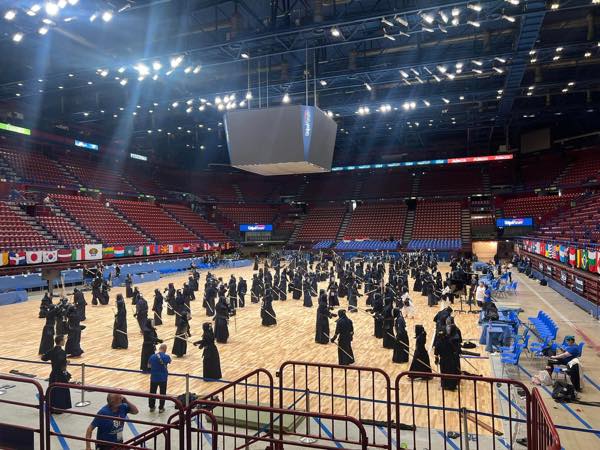
Godo Geiko after the tournament
Day2(JULY 5 – FRIDAY): both WOMEN’S AND MEN’S TEAM CHAMPIONSHIP (PRELIMINARY BOUTS)
Kendo is an individual discipline: we fight one against one,duels,not battles;but in the teams section there is an higher level:here is where the superiority of a nation is really shown,with the addition of the subtle strategy of disposing the order of the fighters.
The second day was meant for both ladies and men teams, where really you can observe the progress the various nations have made.
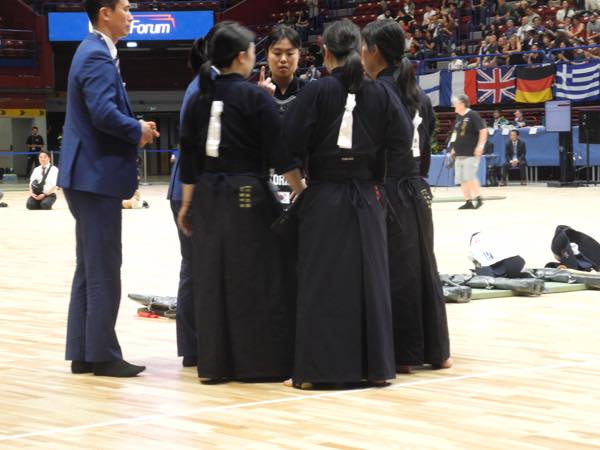
The matches started with the round robin for ladies teams, of which there were 45.After the round robins and the first direct eliminations the competition was stopped to be completed on Sunday.Both Japan and Korea were in a pool of four teams, that allowed two teams to pass. After Japan, then emerged France, and after Korea : Chinese HK. In the Round Robins, Chinese Taipei (as Taiwan had to be called,) won on People’s Republic of China, showing once again their technical superiority and their determination. First match was won with a men by Taipei, whilst second was a draw. Again a men gave another victory to Taipei, and the fourth, with the People’s Republic representative using nito was another draw. the fifth and final, with the match already decided, was another point to Taipei. Then Canada dispatched Brazil and Hawaii.
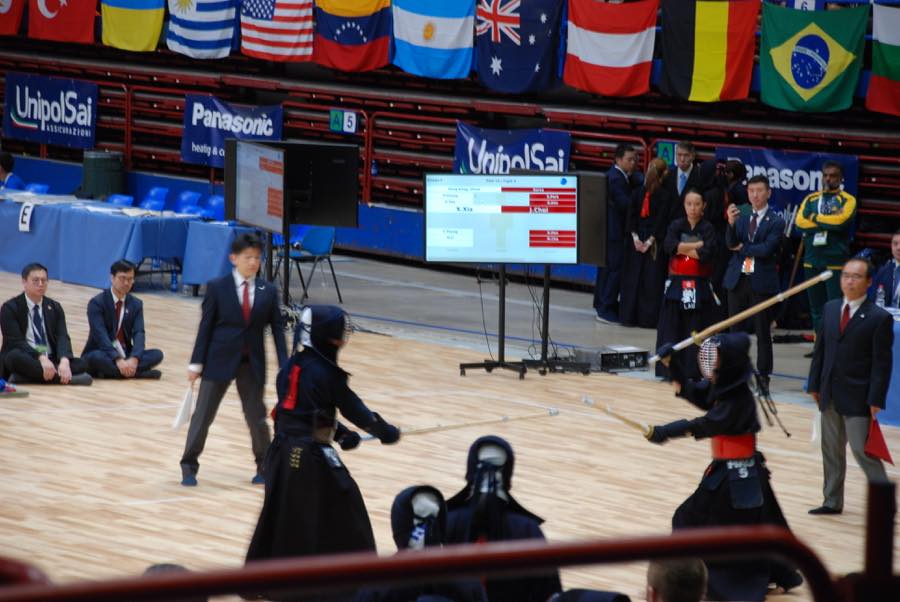
The competitions then shifted to the Males teams Round Robins,in which the luck of the drawings was sometimes felt,as there were pools of three and pools of four, in both cases allowing just one to pass.Many of the matches’ results were predictable, with Japan eliminating Netherlands ,but others were not so evident, like Canada prevailing on Brazil, and Mexico winning on Hawaii. USA eliminated the Italian team, and the very technical and athletic French team, that has proven the best of Europeans, eliminated Chinese Taipei.
It was sensed,by both public and competitors, that the referees seemed in awe everytime Japan competed, also giving ippons that in other occasions could have been denied. As a rule, every point that has been given in this championships has been correctly given,but perhaps some points could have been given that were not.
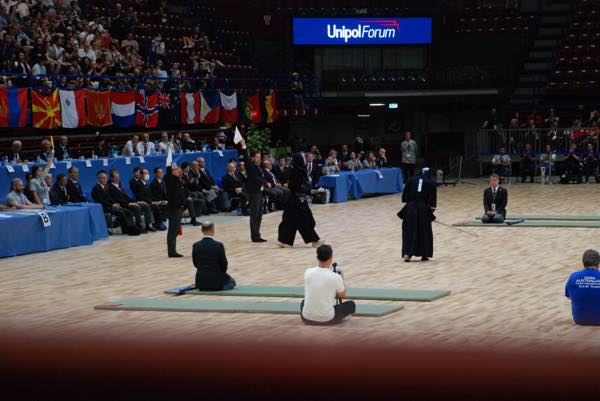
Day3(JULY 6 – SATURDAY): the men’s individuals
The following day was the men’s individuals: 242 athletes that had to be reduced to 64, with pools of three and four from which just a victor emerged.
Of the Italians, just one emerged,only Manzella emerging to be then eliminated by the Hawaiian Fukutomi.
Quite interesting was the match between the Israeli Kaplan and Ngo from Singapore,both using nito, and Kaplan winning. The 64 were reduced to 32 and these to 16, it was quite difficult to follow the most promising matches, as the panels that should have informed the public,with a program supplied by the European Kendo Federation, did not work well and at the best was very late.
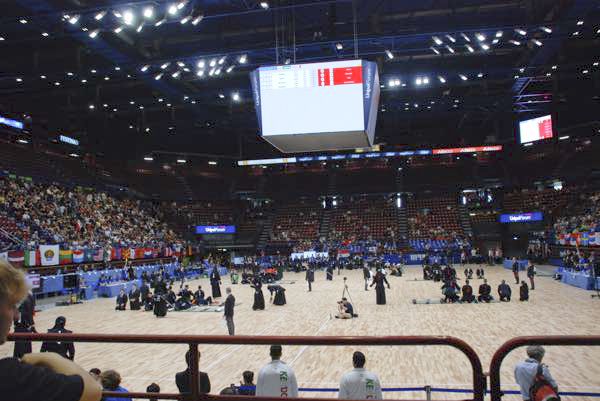
Among these 16 there were seven with a Japanese name, just one Korean, three French , two British, two Australians and just one Korean..
The quarter finals saw the elimination of all the members not part of Japanese team; among them the two British: Wright and Kukas,and the strong USA player Williams. In the semifinals Matsusaki met Kimura, scoring first a men. Kimura soon scored a dō, but Matsusaki shot a very rapid sashimen, that was given by the two side referees.The final between Hoshiko and Matsusaki showed a beautiful Kendo, very powerful and manly. Both athletes gave their best, with periods of study, exchange of seme, and swift exchanges of hits and parries done at lighting speed. Encho, and another, and another, with boh athletes doing their best to pierce the other’s strong and active guard. Suddenly, Hoshiko found the suki, and shot an hiki men that led him to victory, putting an end to this fierce show of swordsmanship.
Winners of fighting spirit were : Kishikawa and Nobu-Jones from Australia, Przelowcki from France, Rukas and Wright from England,Kim and Kwon from Korea and Williams from the USA.

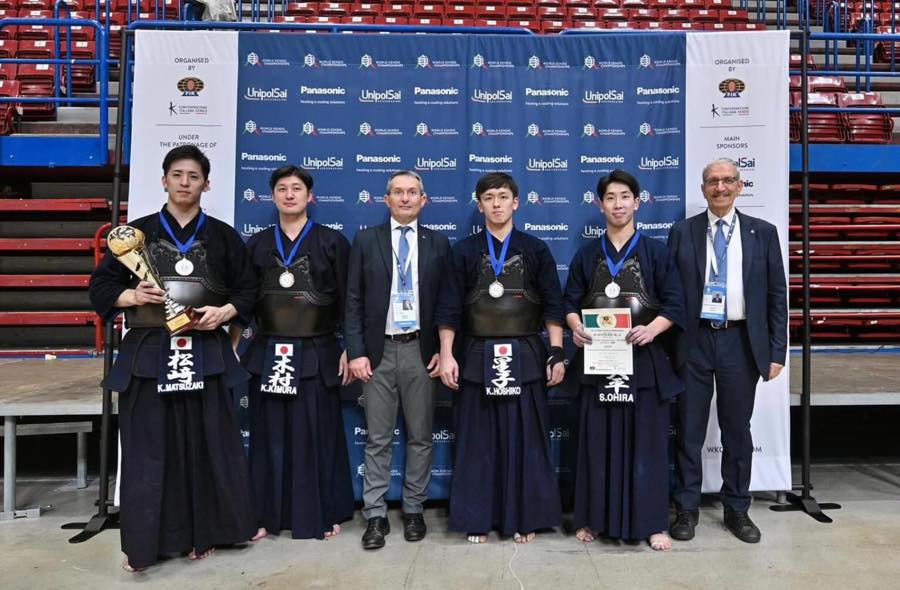
Day4(JULY 7 – SUNDAY): WOMEN’S AND MEN’S TEAM CHAMPIONSHIP (FINAL TOURNAMENT)
The last day opened with the speech of Dieter Hauck, Austrian president of the European Kendo Federation, that had greatly contributed to the realization of these championship in one of their federate nations.
It was soon evident that that the”gentle tsunami” as the public had nicknamed Japanese ladies team had started an unstoppable trip to the victory, with all members winning for two points: first to Hungary then to a good Italian team, On the others shiai jo Australia won on Chinese Taipei (that in the RR had classily eliminated Popular China) . Korea dispatched the valid teams of Belgium and Netherland, Canada had to concede to the USA team, physically very strong and that, like later their male counterpart, used an ugly but effective technique of adhering to the opponent every time it was possible, also not letting them to complete the do cut and so not letting them complete a valid point.

Japan, Australia, USA and Korea were admitted to the semifinals, and the matches between the USA team and Korea was one of the fiercest of the games .The matches resulted in a draw that necessitated a further match. The Korean team chose Choi, Korea 8, whist all USA team blatantly putting on their men not to disclose who would be their champion. At the end it was Matsumoto, number 5 that entered in the Shiai jo. The fight was quite intense, with the tactics of adhering used by the American provoking the fracture of the Korean’s Shinai. At the end, during the encho, Choi scored with a kote that closed the match. In the meantime Japan had won on a valiant Australia.
The final was, evidently between Japan and Korea, with first match between J 5; Matsumoto, and K8 S.Park. The encounter started in a very physical way, with the ladies using tsubazeriai to try to prevail, and then separating to try some action. the Japanese succeeded in an hiki men,the Korean did try but was not able to score and the match finished with one to zero for Japan.
Second match saw Takahashi, J4 against Kor 8 J.Park:a livelier match than the former, with the ladies moving well and some interesting actions. Takahashi scored an hiki men, and, after 6 or 7 seconds, another ippon by debana kote, putting an end to the match.
Third match was between Takenaka J 7 and Han, Kor 2. Quite mobile actions,The Korean took a penalty for the use of tsuba during tsubazeriai, an evident difference in interpretation, as other members of the Korean team had and will be subject to the same sort of penalty.The Japanese lady tried a men that was given by the shinpancho only,to which followed a good gyakudo by the Korean athlete that, unfortunately, passed apparently unnoticed. Again Takenaka hit a debana kote that was signaled by the central but denied by the side referees, so the match finished in a draw.
The fourth match saw the confrontations between Senoo,J 8, and Choi, Ko 3. Not a very long match, with Senoo attacking men, doubling it with another men that scored, and immediately after scoring another ippon with a debana kote.
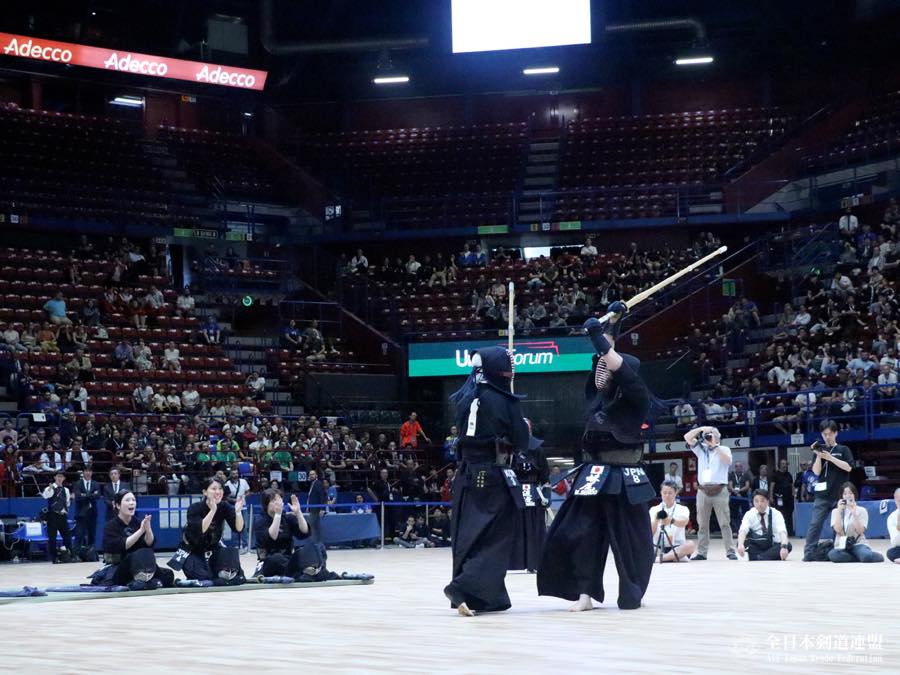
Senoo against Choi (photo: All Japan Kendo Federation)
Last match, with the result of the teams already decided, was between J 1 Watanabe and Kor 1 Cha. Quite soon Watanabe scored a kote, and , a little later with a splendid action, she scored a dai men from toma, that has been considered one of the best point of this tournament. So the Japanese team won 4 to 0.
Then it was time for the males teams competition. The quarter finals made evident that there was a strong superiority of the top seeds: historically the first and the last in the drawings.By the quarter finals, apart from the two seeds, the strongest teams to survive were the USA, that had beaten a strong Australian team, and France, that quite easily won over Spain, after defeating a surprising Mexico, full of spirit, that had been splendidly prepared by their coach:Shiota sensei, with the splendid Jodan player Flores, that had been inspired by the unforgettable Toda Tadao.
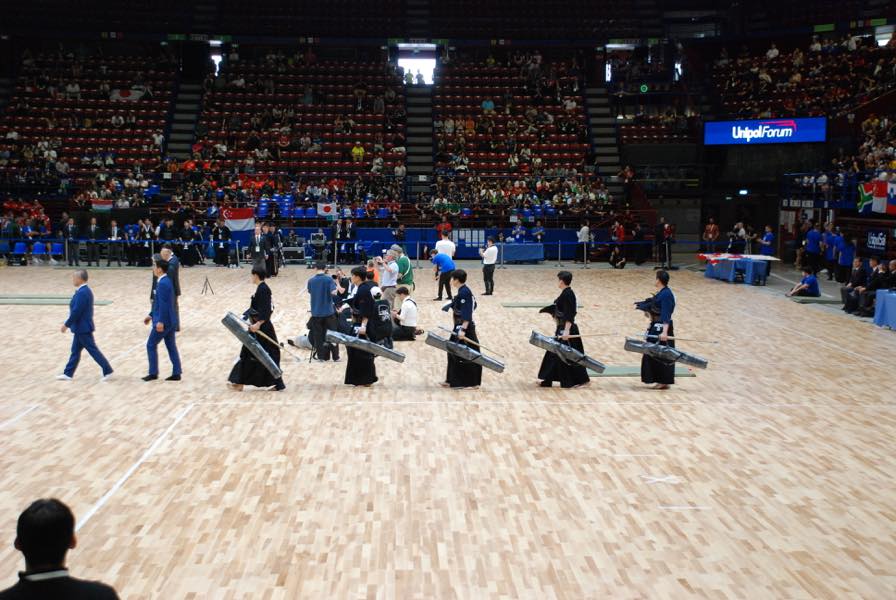
In the semifinals Japan won over France,and it was noted by many, that, apart from the superiority of Japanese, the “Bleus” shared with their opponents the same basic style of fighting.
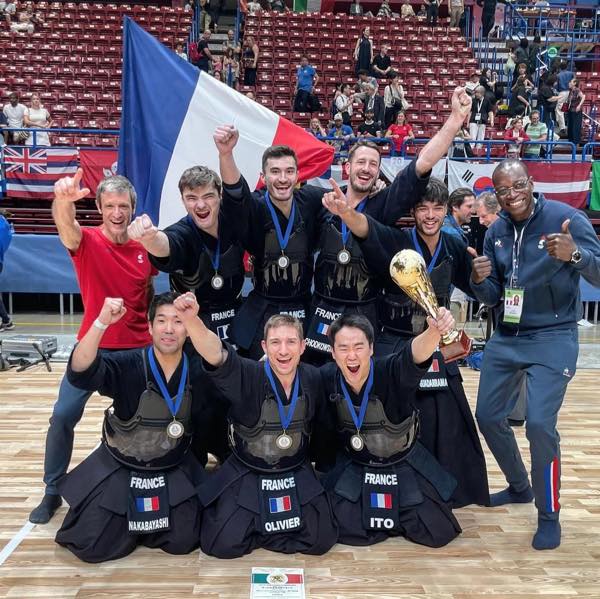
the french team that won the third place
A similar impression was given in the other semifinals by USA and Korea, with the Americans using greatly their phisicity and their “adesion” technique, with the Koreans easily adapting to this system of fight.
We came then to what by many was sensed to be the focus of these championships: the historical final between Korea and Japan, which the continentals having approached the Japanese in style, if not in strength.
Unfortunately, by many, it was felt that the chief Shinpan: the Hawaiian Takahashi, flanked by an USA and a Finnish referee had not been adequate to his task, interrupting the match with many unnecessary gogi .From nearly everywhere it is felt that the finals should be refereed by some Japanese hachidan, that undoubtably have the experience and the personality to guide fairly such important matches.
First match was between Hoshiko that the day before had won the individuals, and Kwon. There was much study between the two, with very clean taiatari before taking the right maai to explode in flashy actions, with the Korean less stable or perhaps not liking the slightly slippery floor and falling.The match went , till Hoshiko, at min 4,45 exploded in an unbeatable hiki men. The match went on with the same fire in both,, At the end Hoshiko won for one point.
Second match was between Matsusaki and C Lee, Here the taiatari were less composed, returning to a style of fight that reminded old championships. After a couple of minutes Matsusaki launched a splendid dai men attack, scoring what, in my opinion, was one of the best actions of this tournament. After a penalty given to Lee, and a break asked by Matsusaki to adjust the shinai, the match continued very lively, to end with Japan scoring the second victory for a point.
The third match, between Kusano, that played Jodan and Park, was considered pivotal, and started in a very active way, with some hits that were not considered. On an action, whilst retreating, Kusano raised his hand, and contemporarily the shinpan cho gave the yame and the Korean hit men. The Japanese player said that his helmet had been displaced and asked to put it straight, with the referee agreeing.
At this point, the Korean coach raised the protest flag and with his interpreter went to the shinpan Shunin complaining on the decision of the shinpan. As often happens, this sort of protest was not received, and the match resumed. The Korean then scored with a very nice hiki do, and soon after polemically asked to replace his helmet and the shinpan Cho refused. Then , soon after, Park scored a second point with a men after attack , giving to his country the victory.
Next match was Takenouchi against Lee, Korea 6. Mr Lee scored first , with a men, but Takenouchi counterattacked, scoring first a kote and then an explosive sashi men that made the match end securing Japan’s victory.
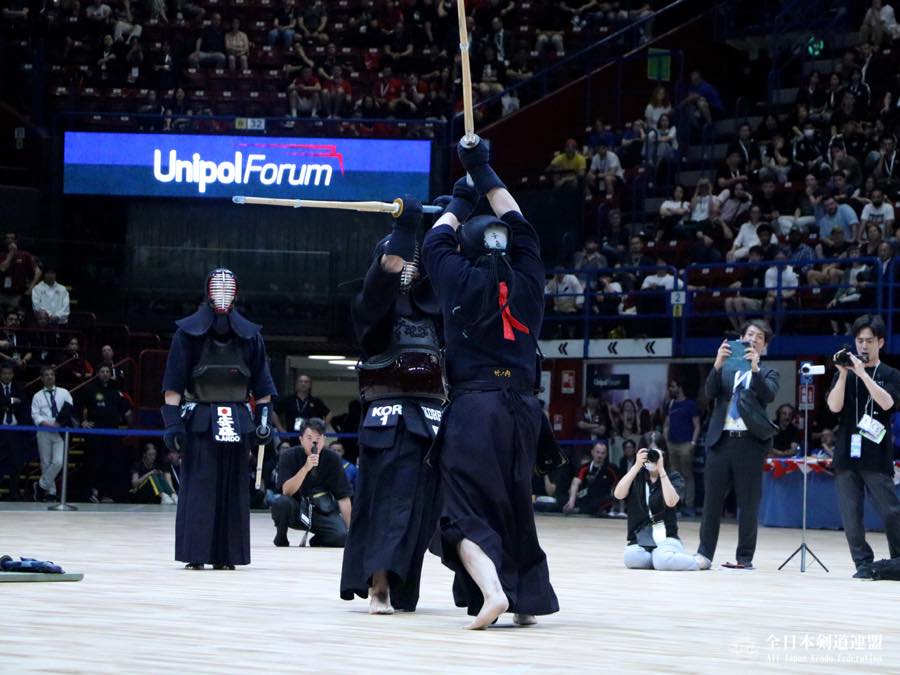
Takenouchi against Lee (photo: All Japan Kendo Federation)
Last match was between Andō and Kim: an old style fight, with many taiatari before retracting to seigan and then some very spirited exchanges. Kim at one point launched a very nice tsuki, that however missed by little the nodowa. The match ended in a draw, with a last blunder of the shinpan Cho giving victory to the Japanese player , and then after having been told, declared the draw.
With this last team fight Japan won the championship and the fights of the tournament ended.

CLOSING CEREMONY
Many are the comments of the athletes, of the team managers and of the various directors on these Championships.
The referees were obviously the main point of discussion, being, as they were, both in the middle of the actions and responsible for the results.
The highest critic was for the referees that judged the male team finals. They were good, sure, but in awe of the responsibility of this judgement,that led to too many gogi that ruined the flow of the encounters,.The great part of the public analyzed this fact saying that perhaps the level of the competitors being let say 90, the lever of the refereeing triad was 70, and so they were not able to rule smoothly the matches.
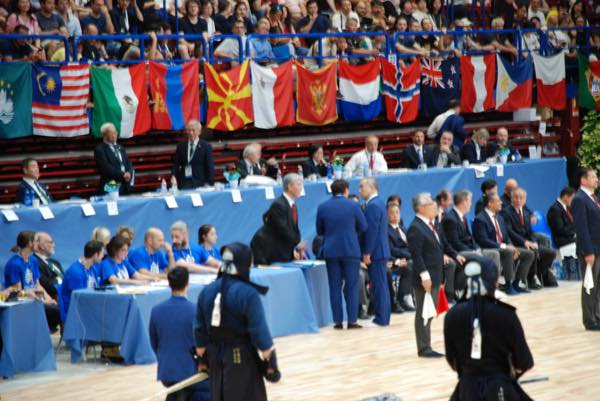
Korean team leader make a protest in teams final
Donatella Castelli, an Italian nanadan with offices both in the European and International Federation,speaking personally, gave this summary of the situation.
Great progress has been made in these Championships compared to the three days versions. To increase the days of competition would become too costly a burden for finance and participants alike. At the same time, our goal and aim should be a bigger participation, as the number of nations will surely increase in the future.One thing that we should accept, for the near ( how much, we do not know)future is the superiority of Japan , where Kendo is born, and of Korea, where it has been practiced for a long time, . These two facts: growth of the movement, and technical superiority bring forward some considerations. One is that the superiority of Japan and Korea should be taken as granted,. The second consideration, being that Japan is better than Korea, and that four Japanese members in the semifinal are a strong result but lead to a less enticing show, leads Castelli to propose to limit the number of individual contenders for nation to just three in number, having as a result, possibly, another national in the semifinals.
Everyone then said goodbye and proposed to be there again, Al together, in the next edition in Tokyo.
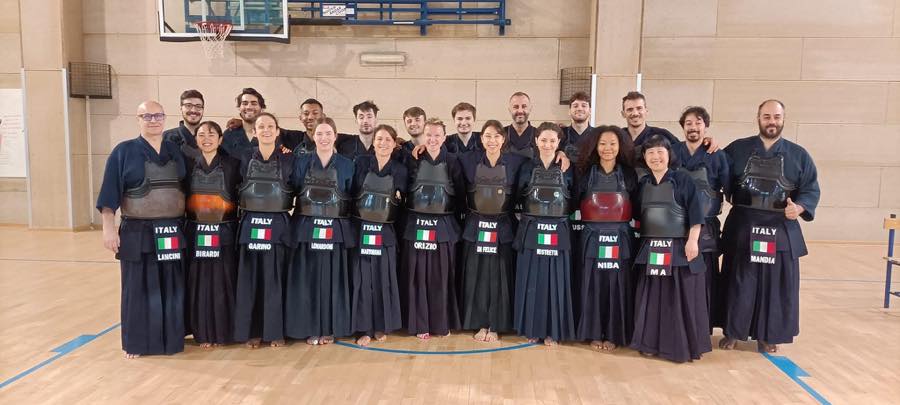
The Italian team
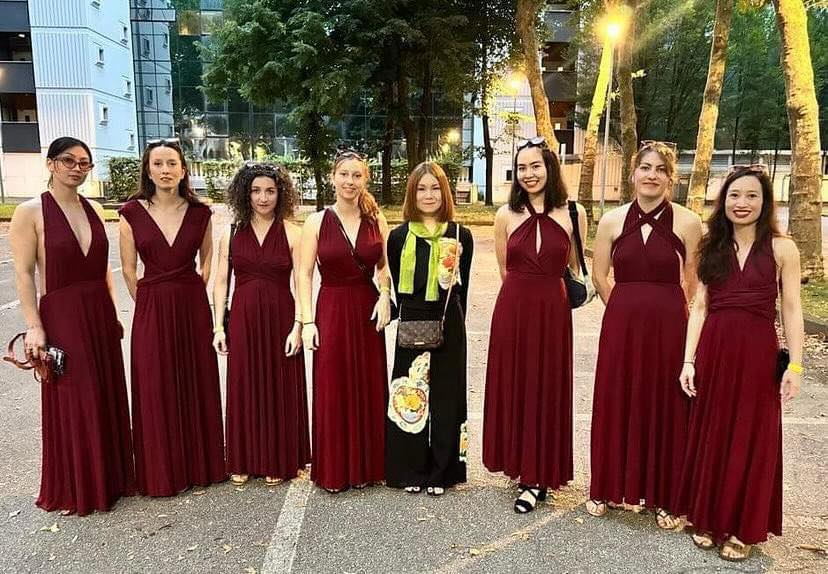
The french Ladies team dressed for the SAYONARA PARTY
Reported by CLAUDIO REGOLI
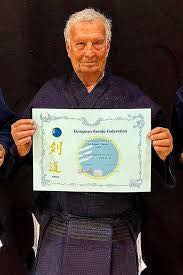 Claudio Regoli started when twelve, with Judo, as part of a family’s traditional military education , comprising fencing, horsemanship, and marksmanship. Continuing with Judo in the famous Busen of Milan, he studied other martial arts, becoming a pioneer in Aikido, in Iai and in Kendo and studying under the best teacher of various arts.
Claudio Regoli started when twelve, with Judo, as part of a family’s traditional military education , comprising fencing, horsemanship, and marksmanship. Continuing with Judo in the famous Busen of Milan, he studied other martial arts, becoming a pioneer in Aikido, in Iai and in Kendo and studying under the best teacher of various arts.
Director of two martial arts magazines, he continued in his quest with many trips in the Far East,studying also different Chinese styles and competing in various fights of Thai Boxe and Full Contact. Author of many books on Karate, Kung Fu,and Kendo, he has been involved in various defense and close combat organizations.
Head of the club of Martial Ediucation “Tengukan”, he has led it in many international competitions, He introduced the traditional Kobudo School Tenshin Shoden Katori Shinto ryu in Italy, becoming Italian Shibucho-Kendo nanadan, and expert of Hoplology, he goes on with teaching and his personal improvement.
Tengukan Heiho Dojo Milano

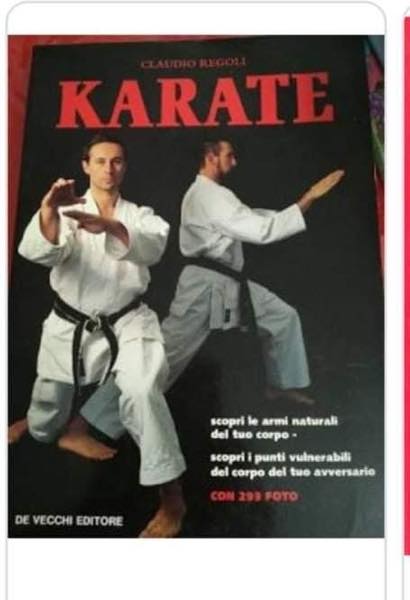
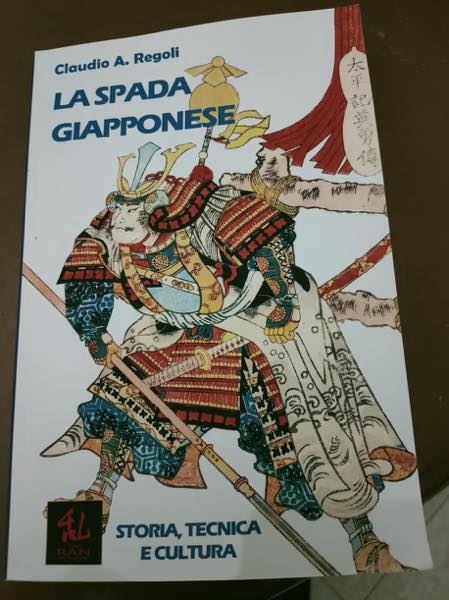
Related Article: A SHORT HISTORY OF KENDO IN ITALY



